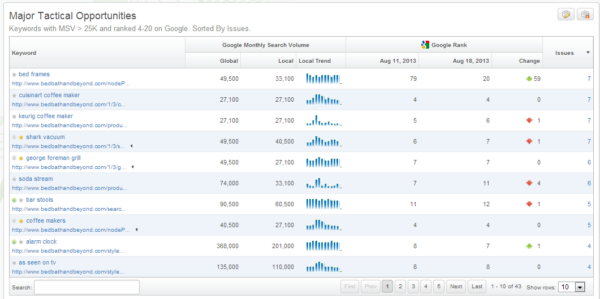The End Of One-Size-Fits-All SEO Reporting
If your organization is like most, the process of establishing KPIs to track natural search probably looks something like this: “Put together high-level KPIs such as X and Y, and run it by a few key stakeholders.” At first glance, that process likely seems to have worked pretty well — after all, few stakeholders make […]
If your organization is like most, the process of establishing KPIs to track natural search probably looks something like this: “Put together high-level KPIs such as X and Y, and run it by a few key stakeholders.”
At first glance, that process likely seems to have worked pretty well — after all, few stakeholders make much noise about the reporting. But that should not necessarily be accepted as an indicator that your SEO reporting is working.
Our experiences at Conductor have shown that there are two general categories of stakeholders when it comes to SEO reporting in the organization:
- Those who believe the current SEO reporting is good enough for them
- Those who are not paying much attention to SEO reporting because it’s not the right reporting for them
Our experience has further shown that, when you dig into it, different stakeholders actually have unique reporting requirements. The VP wants X, the Director of E-Commerce wants Y, and the content creators want Z.
They Don’t Yet Know What They Don’t Yet Know
This reporting challenge is often further compounded by the fact that, most times, they don’t yet know what they don’t yet know. In this case, they don’t yet know that even slightly different reporting might make an immense difference in their ability to glean insights into their online business.
That means that the following is your job:
- Start by asking if the current reporting maps to the view each stakeholder wants/needs of the business.
- No matter the answer to #1, come prepared with some alternative views of the online landscape for the stakeholder to consider. As a general statement, the higher up the food chain the stakeholder, the higher level view is wanted (i.e., an executive wants a “high level” view of search performance, whereas an individual contributor may want a “keyword-level” view).
The example dashboard below, built for the VP interested in a high-level view of site performance, includes the top five keywords driving revenue and a mashup of revenue, SEO traffic, email signups and search visibility data.
The Director of E-Commerce, most interested in the competitive landscape, sees week-over-week competitive trends, a competitive alert dashboard and a summary of market newcomers:
The SEO practitioner, while interested in the high-level view, is also uniquely interested in a more granular, keyword-by-keyword view:
Evolve Out Of One-Size-Fits-All Reporting
It’s time we stop pretending that a one-size-fits-all reporting schema works for all levels of the organization and provide our stakeholders with the data they need to run a fast paced, highly competitive business in today’s online landscape.
The benefits to you as a practitioner are that you become the hero, equipping decision makers with the information they need (and probably didn’t know they needed) to make intelligent decisions.
The benefits to your organization are that key decision makers are now better equipped with the information they need to make informed decisions. So, wherever you are in your reporting, resolve to at least explore how you might provide key stakeholders in your organization with the data and insight they need to succeed.
Contributing authors are invited to create content for Search Engine Land and are chosen for their expertise and contribution to the search community. Our contributors work under the oversight of the editorial staff and contributions are checked for quality and relevance to our readers. The opinions they express are their own.
Related stories
New on Search Engine Land


